|
HTML File Size: 102k Loading ...
Part IV
Basic information on Nippon Kogaku K.K.
Stereo-Nikkor f=3.5cm 1:3.5
Special Purpose wideangle lens.
Year Introduced: December, 1956; Discontinued: 1961/2 |
| |
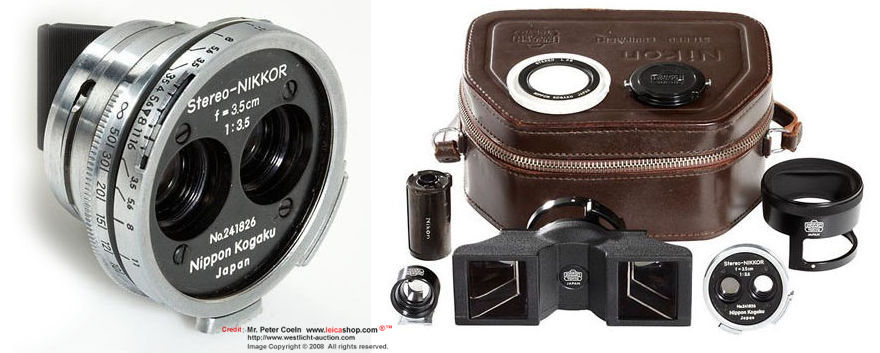 |
| |
| Stereoscopic photography
is simply creating or enhancing the illusion of depth in an image by presenting two
offset images separately to the left and right eye of the viewer. Stereoscopic view,
was like the 3D view had long been existed, even during the mid '30 but only confine
to fun and casual usage. In the 1950s, stereoscopic photography had again regained
certain level of popularity when a number of manufacturers, in particular Leitz and
Zeiss began introducing stereoscopic cameras to the public. Nikon had followed, but
it proved the hype was short-lived, which ended some of the Stereo-Nikkor made during
that period rarest among within the Nikon rangefinder lens group. If you are interested
in taking a look at the Leitz/Zeiss version of Stereo lenses CLICK comparing |
Zeiss
IKON's Stereotar.C
1:3.5 f=35mm / Stereotar.C 1:4 f=3.5cm | Leitz's Elmar 3.5/3.5cm / Stemar
3.5/3.3mm
Stereo Outfit as these German manufacturers were earlier pioneer in development of
stereo equipment. |
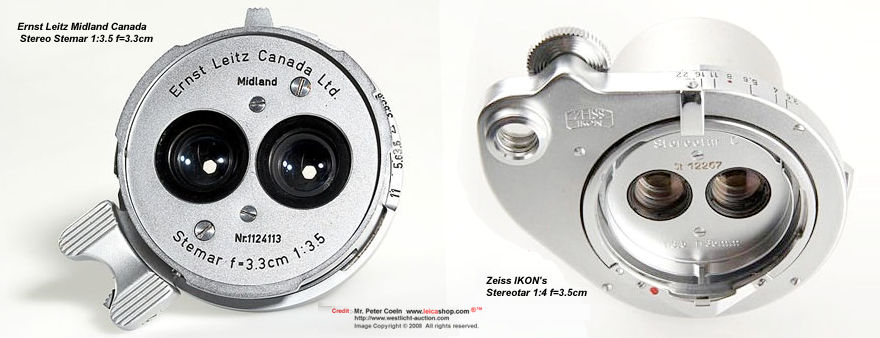 |
| |
Unlike today, professional stereoscopic applications
during the period was not too extensive, meaning stereophotography was still largely
remained as leisure, hobbyist territory. Whatever the reasons the Nikon entry into
stereoscopic photography was a failure from commercial point of view. But it ended
up with one of the rarest Nikkor optic available today for Nikon enthusiastenthusiast
collectors. Today, stereoscopic 3D application can extend to specialized fields such
as in scientific, medical and even in space research, and combining the ease of digital
imaging, it may or may not, in someday one of the leading player in camera manufacturing
may start the game all over again.
Even today, there is very little
information available on the Stereo-Nikkor. There are some conflicting views on the
total number of production as well where some said it was approx. 100 of these had
been sold while recently a Japanese magazine quoted quite confidently that probably
around 200 of these were distributed domestically and abroad. Similarly, all we know
the lens has a 4 elements optical formula with a minimum aperture of f/16. Considering
the available Nikkor 35mm with 4 elements optical formula, probably it has some association
with the same used on the earlier W-Nikkor.C
1:3.5 f=3.5cm. Anyway,
if ever any of you has conclusive view on this area, do help to furnish information
to patch this missing link. |
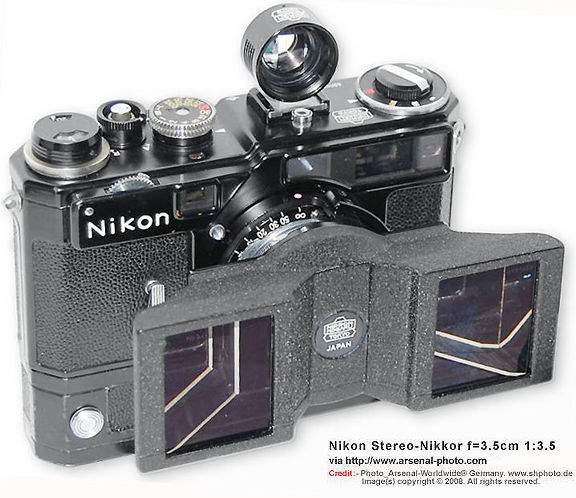 |
One of the main reason of its small number
in existence today was, other than it is mainly designed for stereoscopic usage,
the Stereo Nikkor was sold as part of a stereo outfit, meaning it was not sold independently
like other Nikkor lenses and has a general application like a wideangle lens. This
could had limited its widespread distribution due to high cost factor where typically
an outfit had a price tag not too far from getting an exotic, ultra high speed Nikkor-N.C
1:1.1 f=5cm !
Besides, in a typical general stereography setup, it usually comprised of a Stereo-Nikkor 3.5/3.5cm, caps, stereo prism, hood, filter(s),
a dedicated stereo finder and leather case as standard. Further, depends on affordability
as well as purpose of the potential owner to acquire such as lens, other accessories
such as stereo viewer , special Nikon metal film spool and even projection lens etc.
were also available as optional accessories. All these entries in different configurations
for different level of interest could easily demand for financial affordability of
individual.
|
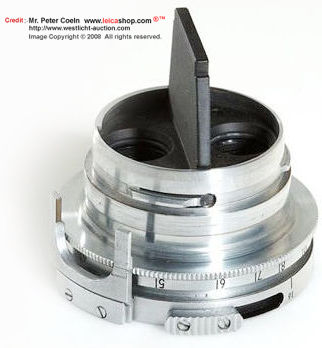 |
Stereo with the Nikon includes a matched
pair of 3.5cm Nikkor, auxiliary prisms for altering the effective lens separation
for correct stereo rendition of more distance objects, and a special stereo finder
that defines the exact field of view of individual stereo frames. The Stereo-Nikkor
lens itself is a matched pair optic, which is mounted in a barrel. Each has an angle
coverage of approx. 45.5° with separation
optical point at 18mm. A divider prevents overlapping of two captured stereo images
which is 17 x 24mm each, just like a half frame camera result but within the same
picture frame of 36 x 24mm. The stereo wideangle lens can control via the apertures,
from f/3.5~f/16 but maximum depth of field is always encouraged in order to achieve
better stereo results. Other general supplied accessories for the Stereo-Nikkor includes
a lens hood which can be mounted onto the front bayonet, and a 40.5mm ultraviolet
filter for general and/or protective usage.
For optimum picture composition and Stereo alignment, a special optical finder was
supplied as standard accessory. The finder is basically the same with the black 3.5cm
BL (bright frame line) finder but it is marked with a "stereo" word at
the front. The main difference of this 3.5cm Stereo Finder has a rectangular, vertical
dotted line within the bright frameline which indicates the upper limit of the actual
picture angle as well as the required parallax compensation. It can be slide into
the camera accessory shoe.
|
|
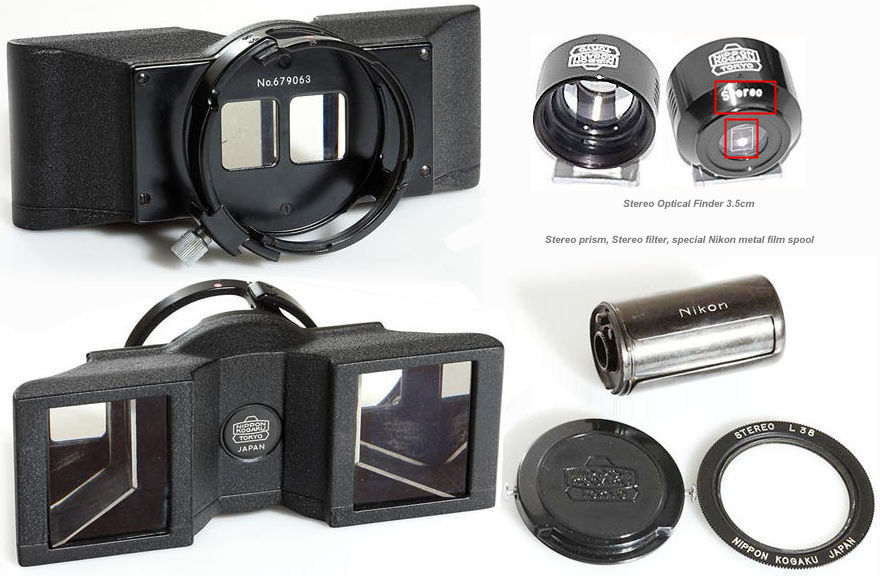 |
|
|
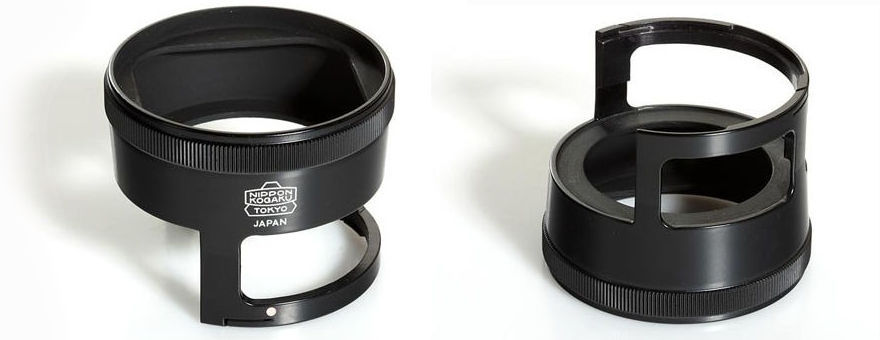 |
| The Stereo-Nikkor
couples with the Nikon RF camera is theoretically be used for all distances from
3ft ~OO but must couples with accessory stereo prism for distance beyond 10 feet.
Meaning if using the lens alone, it should be advised use within the range of 3'~10'.
The fact is, the 35mm wideangle can also be used for distances beyond the limitation
but just reduces the pronounced stereo effectiveness. In short, for best stereoscopic
effect, it is good to maintain effective working distance it designed for, but for
range beyond, just attach the stereo prism. In using the lens for stereography, it
is always advisable to maintain the lens leveled with the subject/object of your
interest, avoid tilting up and down as the angle twist may make unmatched visual
results during viewing. |
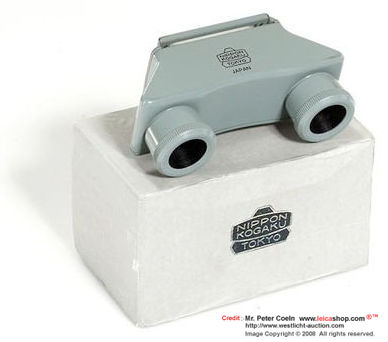 |
Nikon Stereo Slide Viewer
During those days, it is possible to look for shops processed the final images
and returned them mounted in pairs of 2" x 2". For quick viewing, Nikon
had designed a gray-painted, but metal Stereo Viewer. The portable hand viewer is
far superior in design and appearance than the likes of Leitz and Zeiss Ikon. But
the German probably has the edge in also delivering their own stereo projection lens.
We don't have an instruction manual of the Stereo-Nikkor and if anyone of you has
one, please scan or take digital images for us to beef up the content
of this Nikon rangefinder resource library, thanks.
Appropriate credit will be given for any contribution,
please contact my long time web buddy: rick_oleson@yahoo.com
|
 |
|

| Basic Specification for Nikon (Nippon
Kogaku K.K.) rangefinder Stereo-Nikkor 1:3.5 f=3.5cm wideangle lens:- |
| |
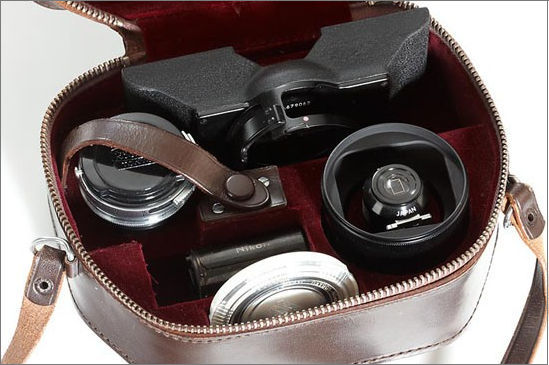 |
Lens Mount:
Nikon S-Mount for RF Nikon. No known LEICA M39 Screw Mount / Contax Bayonet mount
yet
Focal
Length: 35mm (3.5cm);
Diaphragm:
Manual
Focusing
range: 3ft~10ft; 10'~OO require prism.
Picture Angle: 45.5° x 2;
Maximum / Minimum Aperture range: f/3.5 ~ f/16
Optical
Construction: 4 elements
Filter Attachment Size: special bayonet-type (40,5mm)
Lens Hood: standard accessory;
Optical Finder: special Stereo-type, supplied as standard accessory with grid
frame line for defined frame for each lens
Weight (lens only): approx. 198g/7oz
Standard/Optional Accessories:
leather case; optical 3.5cm Stereo finder, Stereo viewer etc.
Other
Information: Quantity Approx. 200 units
|
|
| previous |
4/4 W-Nikkor.C 1:3.5 f=3.5cm
| W-Nikkor.C 1:2.5 f=3.5cm | W-Nikkor.C 1:1.8 f=3.5cm
| Stereo-Nikkor f=3.5cm 1:3.5

Back to - Nikon RF-Nikkor lenses
(Rangefinder):- Main Index Page
Nikon
Auto
Focus
Nikkor lenses:- Main Index Page
Nikon Manual
Focus
Nikkor lenses:- Main Index Page
| Back | Main Index Page of Pictorial
History of Nikon SLRs
about this photographic
web site
 |
Home - Photography in Malaysia
|

Credit:- Special thanks to all the contributors of images
and content which made up the basis of the site. Note:certain content and
images appeared in this site were either scanned from official marketing leaflets,
brochures, sales manuals or publications published by Nikon over the years and/or
contribution from surfers who claimed originality of their work for educational purposes.
The creator of the site will not be responsible for may discrepancies arise from
such dispute except rectifying them after verification."Nikon",
"Nikkormat", "Nippon Kokagu KK" & "Nikkor"
are registered trade name of Nikon Corporation Inc., Japan. Site made with an Apple
G5 IMac.
|